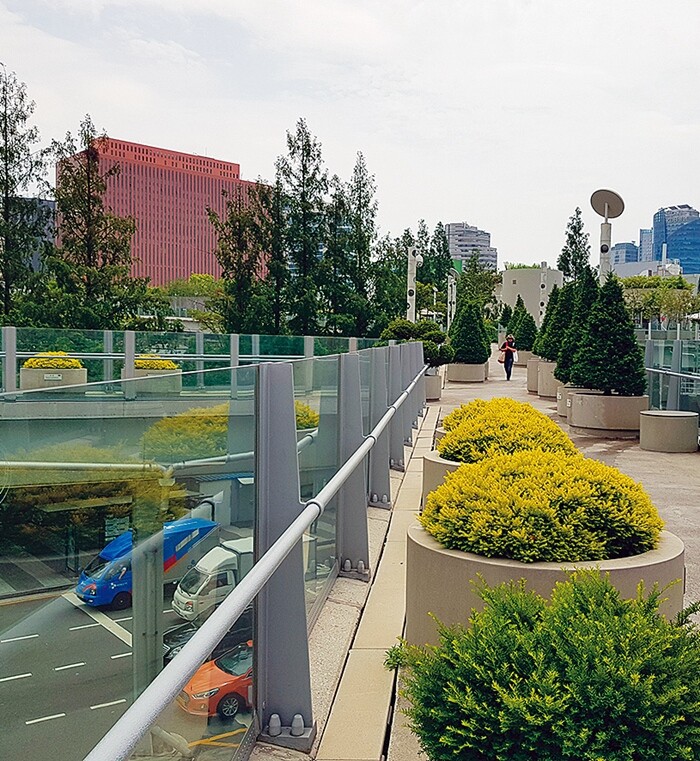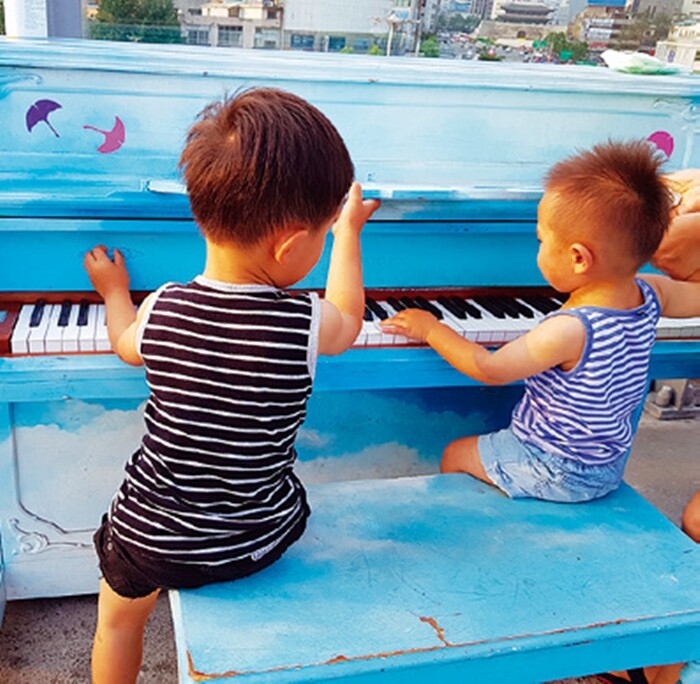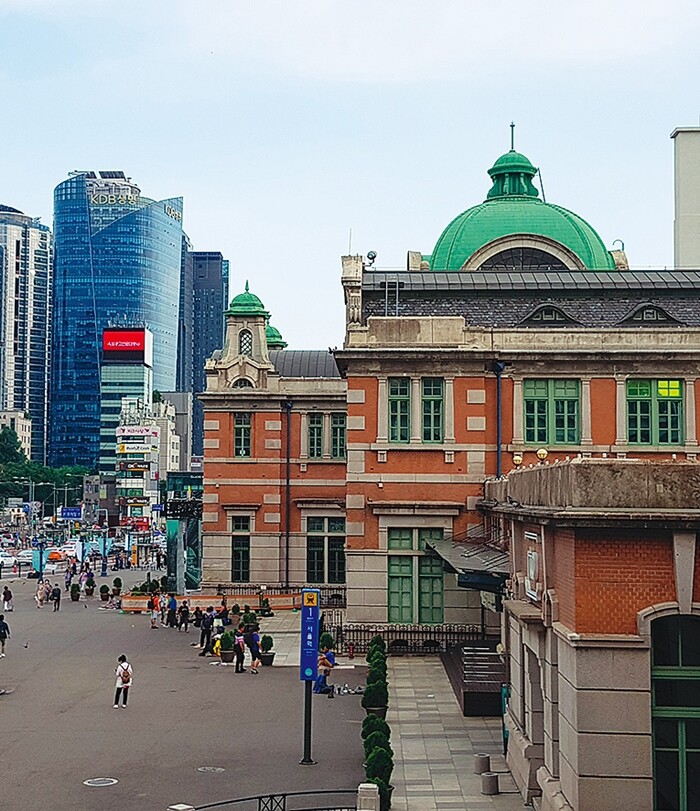hankyoreh
Links to other country sites 다른 나라 사이트 링크
[Seoul travels]Ruminations from Seoul’s first elevated walkway

You think you’ve gotten so far only to find yourself back where you started. Haste makes waste; run too fast, and you’ll trip up. These are times when we need the wisdom to pause and catch our breath.
Hemingway’s life also divided into pre-Corona and post-CoronaSuch mediations bring to mind an unfortunate incident that befell American writer Ernest Hemingway. Due to his wife’s carelessness, a thief at a Paris train station made off with a suitcase carrying a manuscript to which Hemingway had devoted four years of his life. When feelings of rage and futility made it hard for Hemingway to carry on, what brought him comfort and helped him get back on his feet was Corona. I’m not talking about the virus, of course, but the typewriter — more precisely, Corona No. 3.
“The Corona No. 3 is the only psychiatrist I would ever submit to,” Hemingway once wrote.

The Corona No. 3 was the first portable typewriter that could accompany a writer on the road, rather like laptop computers today. Making a fresh start, Hemingway used his typewriter to compose “The Sun Also Rises,” which launched his writing career and earned him the reputation as the leading light of the lost generation. It makes sense, therefore, to divide Hemingway’s life into pre-Corona and post-Corona. Hemingway parted ways with many people in his life, but never with his typewriter, which was truly his life’s companion.
Climb up somewhere high and take a look aroundI’ve started going on walks again for my newspaper column. When the world is full of frustration and uncertainty, one option is to climb up somewhere high and take a look around. My destination this time was Seoullo 7017. For 40 years, this was a vehicle overpass linking Toegye Street with Mallijae Street. Three years ago, however, it became South Korea’s first elevated pedestrian walkway. Where the car was once king, today the people rule.

But what does that unfamiliar number “7017” in the name mean? Apparently, it blends 1970, the year the overpass at Seoul Station opened to traffic, and 2017, the year the overpass was reborn as a pedestrian walkway. When Koreans come up with names, they sometimes try to pack in too much meaning. To be easily memorable, a name should be intuitive and trip off the tongue.
The inspiration for the Seoul 7017 was reportedly the High Line in New York City. That may say something about the difference between projects initiated by the government and by the private sector. New York’s High Line runs for 1 mile, or about 1.6 kilometers (km), while Seoullo 7017 is about 1km long. Another difference between the two is that the High Line was converted from a railroad, while Seoullo 7017 used to be a vehicular overpass.
My plan was to walk from Toegye Street, where Namdaemun Market is located, toward the Mallijae neighborhood. I passed by paths linking to the second floor of the Hotel Manu and the Daewoo Foundation and soon reached the midpoint of the course, which offered a good view of Seoul Station Plaza, Namdaemun Gate, and Yeomcheon Bridge. There was a piano here where a visitor was playing the same tune over and over again. The repetition seemed like a pretty good metaphor for the era we’re living through today.

Kwon Min-jeong, who used to lead walking tours on Seoullo 7017 and currently works nearby, gave me some pointers about the walking course. “There aren’t many good places to get a panoramic view of the streets of downtown Seoul. What’s most fascinating about walking up here is that you can see how the various streets of Seoul are interconnected. From the walkway you can see a total of eight traffic signals stretching past Seoul Square and Seoul Station. Did you know that Seoul Station had a tea room as well as Korea’s first Western restaurant, called Seoul Station Grill? They show up in the fiction of Yi Sang.”
Just as with people, buildings and roads also have important stories to tell, if we dig a little deeper. After my charming conversation with Kwon, I read “The Wings,” a novel by Yi Sang, who wrote in the 1930s, during Japan’s colonial rule of Korea. The first-person narrator of his novel occasionally visits the waiting room and tea room at Seoul Station (called Gyeongseong Station back then). Those locations were in the old station building, which was turned into Culture Station Seoul 284 after the current station was built.
“I read the names of the dishes on the menu several times, from bottom to top, and then from top to bottom. Their ambiguity was somehow similar to the names of my childhood companions,” Yi wrote in “The Wings.”
This neighborhood is layered with memories of Seoul. During the life of Yi Sang, men of letters and men of means used to congregate at the station; more recently, the crowds of passengers have thinned because of the COVID-19 pandemic, leaving homeless people to squabble in the station square. Across from the square is a structure that once seemed a symbol of Korea’s export-driven economy. More than 10 years have passed since the Daewoo Building, as it used to be called, was renamed Seoul Square.

Seoullo 7017 has cafés catering to travelers, some with nice vantage points, but most of them aren’t open for business right now. At various points along the walkway are large round planters called “curiosity flowerpots”; according to material provided by the city, there are 645 of these planters altogether, holding more than 24,000 plants. Seoullo 7017 was designed by Winy Maas, a Dutch architect and landscape, whose plan was selected in an international competition. Maas said that he wanted to design not just a walkway but a botanical garden for Seoul.
While the bulky planters might present an obstacle for people intent on walking, they also serve, somewhat surprisingly, as a rest area for office workers. That was the story I heard from someone who works in one of the big office buildings nearby.
“Young office workers these days call themselves ‘newbies,’ as if they’re at the lowest skill level in a video game. When they get upset about something — getting chewed out by the boss, for example — they come up here and duck behind one of the planters for a quick cry or just to stare up at the sky until they’ve managed to calm down.” Everyone ought to have a place where they can shed a few tears in private, and that’s particularly true in these uncertain times.
Seventeen walking courses have opened around the main walkway, bringing new attention to hitherto underdeveloped neighborhoods such as Jungnim, Cheongpa, and Mallijae. The walkway functions as an artery for urban regeneration. At the same time, a fair number of the small-time shopkeepers in the area complain that the rents have gone up, bringing down their quality of life.
Seoullo 7017 overlooks a city of a thousand personas. How long will we have to wait before this city of a thousand masks reveals the thousand faces behind them?
By Son Kwan-seung, travel writer
Editorial・opinion
![[Column] Season 2 of special prosecutor probe may be coming to Korea soon [Column] Season 2 of special prosecutor probe may be coming to Korea soon](https://flexible.img.hani.co.kr/flexible/normal/500/300/imgdb/original/2024/0426/3317141030699447.jpg) [Column] Season 2 of special prosecutor probe may be coming to Korea soon
[Column] Season 2 of special prosecutor probe may be coming to Korea soon![[Column] Park Geun-hye déjà vu in Yoon Suk-yeol [Column] Park Geun-hye déjà vu in Yoon Suk-yeol](https://flexible.img.hani.co.kr/flexible/normal/500/300/imgdb/original/2024/0424/651713945113788.jpg) [Column] Park Geun-hye déjà vu in Yoon Suk-yeol
[Column] Park Geun-hye déjà vu in Yoon Suk-yeol- [Editorial] New weight of N. Korea’s nuclear threats makes dialogue all the more urgent
- [Guest essay] The real reason Korea’s new right wants to dub Rhee a founding father
- [Column] ‘Choson’: Is it time we start referring to N. Korea in its own terms?
- [Editorial] Japan’s rewriting of history with Korea has gone too far
- [Column] The president’s questionable capacity for dialogue
- [Column] Are chaebol firms just pizza pies for families to divvy up as they please?
- [Column] Has Korea, too, crossed the Rubicon on China?
- [Correspondent’s column] In Japan’s alliance with US, echoes of its past alliances with UK
Most viewed articles
- 1‘We must say no’: Seoul defense chief on Korean, USFK involvement in hypothetical Taiwan crisis
- 2AI is catching up with humans at a ‘shocking’ rate
- 3Is Japan about to snatch control of Line messenger from Korea’s Naver?
- 4Division commander ordered troops to enter raging flood waters before Marine died, survivor says
- 5[Column] Season 2 of special prosecutor probe may be coming to Korea soon
- 6Is N. Korea threatening to test nukes in response to possible new US-led sanctions body?
- 7[Guest essay] The real reason Korea’s new right wants to dub Rhee a founding father
- 8Korea sees more deaths than births for 52nd consecutive month in February
- 9[Editorial] Korea’s surprise Q1 growth requires objective assessment, not blind fanfare
- 10One Hyundai worker suffers through 16 piecemeal contracts in 23 months